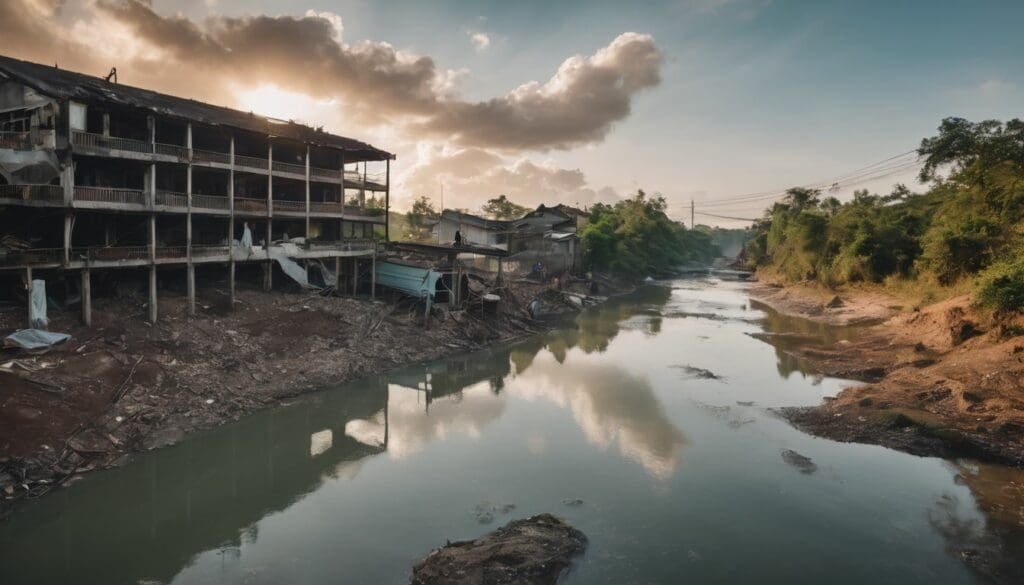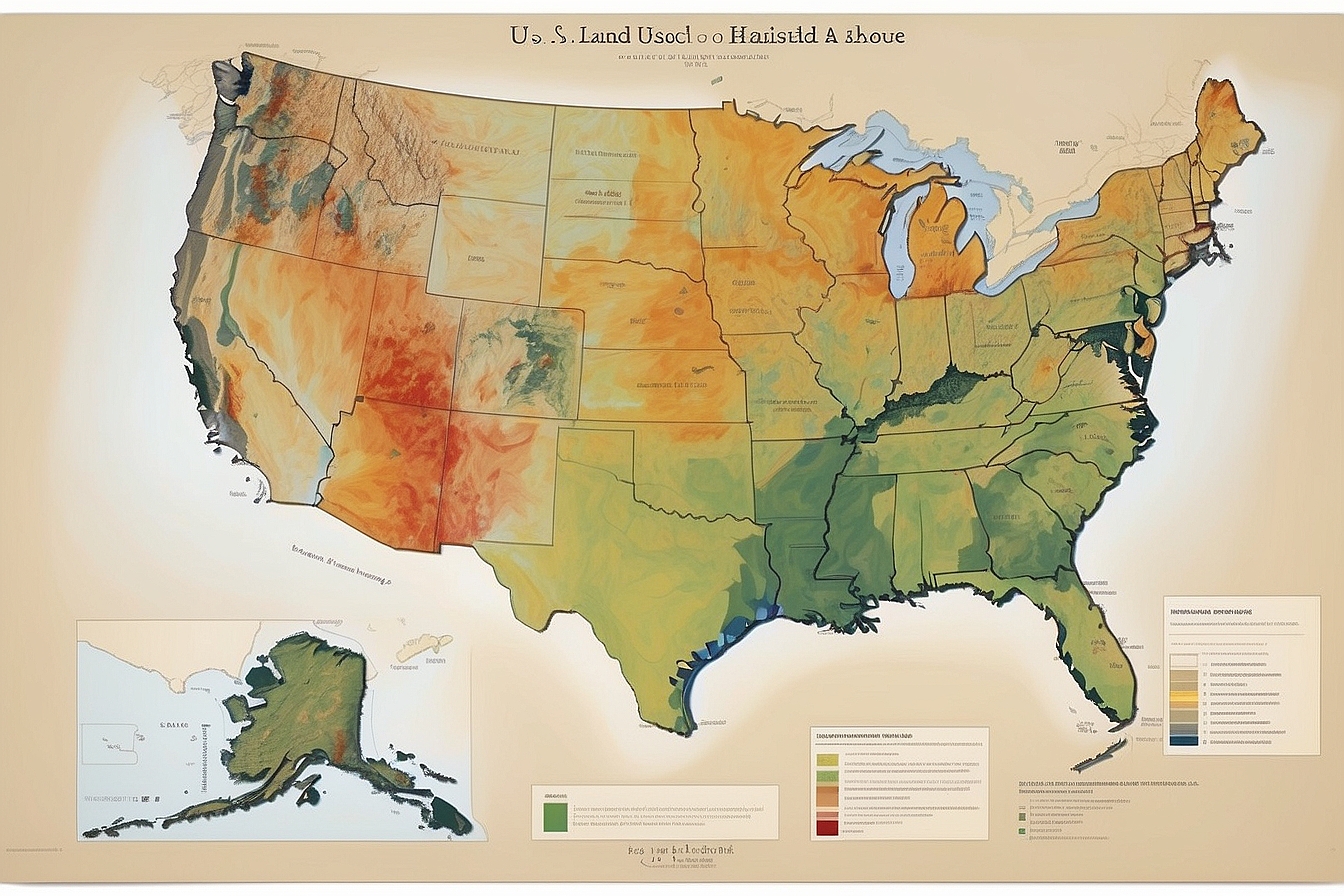Have you ever caught yourself pondering the impact our land-use decisions have on the delicate balance of nature? It’s a thought that has crossed many of our minds, particularly when faced with the stark reality that urban sprawl can lead to a whopping 55% increase in surface runoff.
We’ve taken a deep dive into this intricate topic and are ready to shed light on the often-complex interplay between land use and environmental pollution. Join us as we navigate these waters together and look towards adopting more considerate approaches to protect our precious planet for future generations.
Key Takeaways
- Agricultural practices can cause water pollution through runoff carrying fertilisers and pesticides into streams and rivers, which leads to algal blooms that harm aquatic life.
- Urban development increases impervious surfaces like roads, which lead to more runoff polluted with oil and chemicals entering water bodies; additionally, air pollution from vehicles affects environmental health.
- Forests act as natural filters for water quality, but deforestation contributes to soil erosion and sedimentation in rivers, posing a threat to wildlife habitats.
- Runoff from different types of land carries pollutants such as microplastics and pathogens into water sources, affecting human health and ecological balance.
- Remote sensing technology helps monitor the impact of land use on water quality by tracking changes in land cover over time, aiding management strategies for pollution control.
Impact of Land Use on Water Quality
Land use has a significant impact on water quality, with agricultural land contributing to nutrient runoff and urban land leading to increased pollutants from human activities. Forest land plays a role in filtering water, but deforestation can lead to soil erosion and degradation of water quality.
Agricultural Land
We often overlook the role of agricultural land in shaping our environment, but it’s a critical piece of the puzzle. Farms and crop fields can directly impact water quality through runoff that carries fertilisers, pesticides, and other chemicals into streams and rivers.
These substances boost nutrient levels in water bodies, fostering algal blooms that deplete oxygen and harm aquatic life. We must adopt sustainable agricultural practices to reduce this nonpoint source pollution.
Implementing strategies like buffer zones around waterways helps capture these pollutants before they cause damage. As stewards of the land, we embrace changes such as rotating crops, reducing tillage, and carefully managing chemical use to lessen environmental impact.
Our commitment to sustainable development means constantly seeking ways to balance food production with ecological preservation on agricultural lands.
Urban Land
Urban land development has a significant impact on water quality and pollution. As urban areas expand, there is an increase in impervious surfaces such as roads, car parks, and buildings that prevent water from soaking into the ground.
This leads to more runoff carrying pollutants like oil, chemicals, and litter into nearby bodies of water. Additionally, urban land use contributes to increased water contamination from industrial emissions and wastewater disposal.
The ecological effects of urbanisation include habitat destruction and wildlife habitat loss due to the conversion of natural landscapes into developed areas. Management strategies for urban land are essential for controlling pollution and protecting water quality.
Forest Land
Moving on from urban areas, forest land plays a crucial role in maintaining water quality and controlling pollution. Forests act as natural filters, trapping pollutants and preventing them from entering surface water sources.
The dense root systems of trees help stabilise soil, reducing erosion and limiting the amount of sediment that can flow into water bodies. Moreover, forests also absorb excess nutrients such as nitrogen and phosphorus, which would otherwise contribute to pollution in streams and rivers.
Additionally, forests provide essential habitat for wildlife which contributes to biodiversity conservation. Their ability to sequester carbon dioxide helps mitigate climate change impacts.
Link Between Land Use and Pollution
The effects of runoff from various land uses can lead to pollution in surface water, impacting water quality and ecological health. Sources of pollution from land use, such as agricultural runoff and urban development, contribute to the degradation of the environment.
Understanding the influence of land use on water quality from a remote sensing perspective can provide valuable insight into managing and mitigating pollution.
Effects of Runoff on Pollution
Runoff from agricultural land, urban areas, and forested regions transports various pollutants such as pesticides, fertilisers, oil residues, and litter into water bodies. As a result of this runoff, surface water quality is degraded due to an increase in microplastic pollution and sedimentation.
The flow of contaminants like chemicals and nutrients through runoff poses a significant threat to the ecological balance of aquatic ecosystems. Moreover, it contributes to the overall pollution levels in rivers, lakes, and oceans.
Runoff from different land uses also influences the presence of pathogens in water. For instance, urban stormwater carries bacteria from pet waste and sewage leaks while agricultural runoff contains pathogens associated with livestock manure.
These microbial pollutants pose health risks to humans who come into contact with polluted waters for recreation or consumption.
Sources of Pollution from Land Use
Pollution from land use comes from various sources such as chemical fertilisers, pesticides, and herbicides used in agriculture. These substances can leach into the soil and contaminate water supplies through runoff when it rains.
Urban development also contributes to pollution with increased impervious surfaces like roads and pavements, which prevent rainwater from soaking into the ground naturally. Instead, it collects pollutants and carries them directly into nearby water bodies during heavy rainfall.
Deforestation can lead to erosion, causing sedimentation that degrades water quality by clouding streams and rivers.
In addition to these direct sources of pollution, human activities linked to land use contribute to ecological degradation at a larger scale. Industrial operations near or within natural habitats result in additional contamination through waste discharge or accidental spills.
All these factors combined highlight the complex relationship between human land use decisions and their impact on environmental health.
Influence of Land Use on Water Quality from Remote Sensing Perspective
Remote sensing offers a powerful tool for assessing the influence of land use on water quality. By using satellite imagery and other remote sensing techniques, experts can monitor changes in land cover, such as deforestation or urban expansion, which directly affect water quality.
This technology enables us to detect alterations in the natural landscape that could lead to pollution and degradation of water sources. Furthermore, remote sensing provides valuable data on the extent of agricultural activities and their impact on nearby water bodies.
Through this method, environmentalists and policymakers gain insights into how different land uses contribute to pollution.
Understanding the link between land use and water quality from a remote sensing perspective empowers us to make informed decisions about conservation efforts and pollution control measures.
Remote sensing not only helps identify areas at risk but also facilitates proactive planning and management strategies for maintaining clean water resources.
Conclusion
Understanding the impact of land use on water quality is crucial. It affects agricultural, urban, and forest lands differently. Land use directly influences pollution levels in water bodies.
Runoff and sources of pollution stem from various land uses. Remote sensing provides valuable insights into the connection between land use and water quality.
FAQs
1. How does land use affect pollution levels?
Land use impacts pollution because different activities, like farming or industry, can release harmful substances into the air and water.
2. Can good land management reduce pollution?
Yes, effective land management can help control and lessen the amount of pollution that enters our environment.
3. What is the role of water management in preventing pollution?
Water management plays a key part in stopping pollutants from spreading by controlling how we use and treat water on lands.
4. Why should we care about the link between land use and pollution?
Understanding this link is important as it helps us make better choices to protect our natural surroundings for a cleaner planet.





